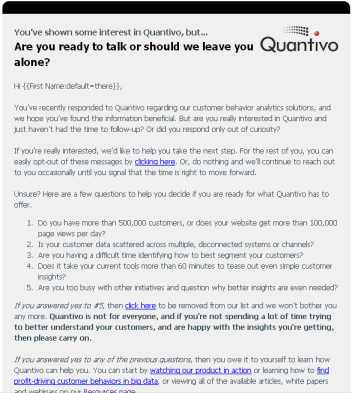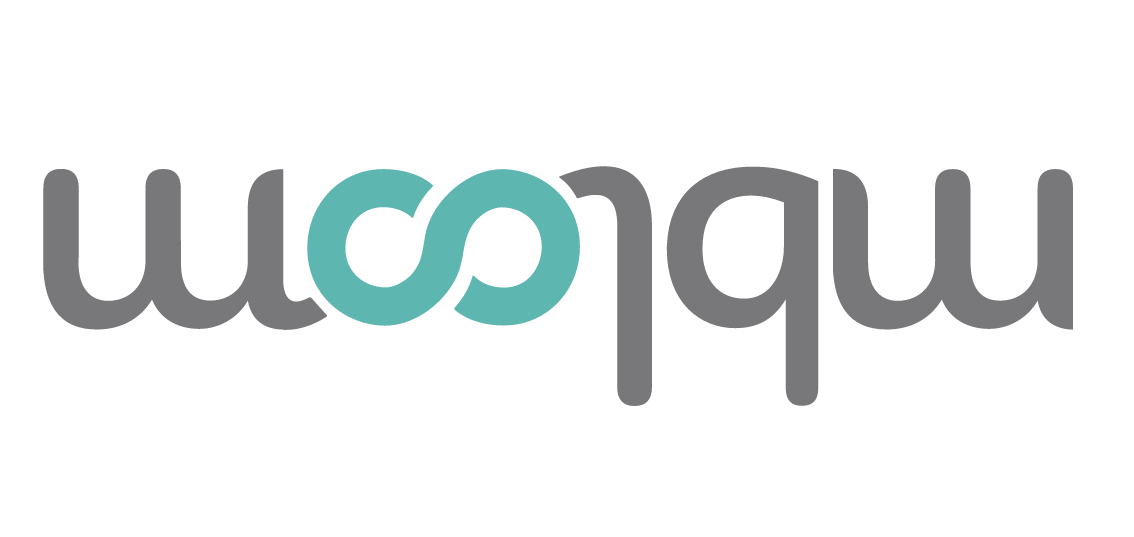Most email marketing advice takes a negative approach to the unsubscribe link, offering ways to reduce, eliminate, or talk your way out of prospects removing themselves from your marketing lists. However, there are cases when the opposite is, in fact, the better course of action or the required focus of a campaign. Let me explain…

At my current company, I’ve been able to drive a huge amount of leads with some of our more compelling offers, especially the Behavioral Analytics For Dummies book, which has generated over 6,000 leads in just nine months. That may sound like a good thing, but that volume of leads – combined with leads from other campaigns – can overwhelm a sales team very quickly. With that many leads, our sales development and field sales reps spend more and more time on leads who were only interested in the offer, not our products. As lead volumes increase, so, obviously, does time wasted on uninterested leads.
Do you need a push?
This is where the magical unsubscribe offer originated. Since my campaigns had been very successful, I began to think that maybe the emails, calls-to-action, and content were too interesting. I was crushing my lead gen KPIs, but was overwhelming our team and needed a way to separate the proverbial (and valuable) wheat from the uninterested chaff.
While I toyed around with various messages to incent interested leads to act, it became clear that that was the wrong approach. Every email blast tries to incent interested leads to act, but essentially ignores the uninterested leads until the footer of the email. Working with my #1 marketing guru, John Love, we decided to focus the message on helping people to unsubscribe!
To begin, our subject line was, “You’ve responded, but are you really interested?†We offered the unsubscribe link as the very first call-to-action of the email: “If you’re really interested, we’d like to help you take the next step. For the rest of you, you can easily opt-out of these messages by clicking here.â€
Then, we offered a few qualifying questions that allowed those curious but unsure to decide before moving on, with #5 being asking if they were too busy to improve their business. Again, we almost pushed people away with the subsequent sentence: ” If you answered yes to #5, then click here to be removed from our list and we won’t bother you any more. Our solution is not for everyone, and if you’re not spending a lot of time trying to better understand your customers, and are happy with the insights you’re getting, then please carry on.”

Thank you for unsubscribing!
The results: Over 150 unsubs on just under 2,000 contacts, or a 7.5% unsubscribe rate! For perspective, my unsubscribe rate has been extremely low compared with some recent B2B benchmarks that list 0.6% as typical for IT solutions, or this estimate of 0.2 – 0.75% unsubs on lists to which you “communicate regularly.â€
For comparison, my previous 2010 high volume of unsubs for a single campaign was 15 on a targeted list of 3,000 contacts – a more-typical 0.5%. However my rate is usually much, much lower, with just four or five total unsubs on campaigns that hit over 5,000 very targeted contacts.
Success in the form of failure
Overall, this was a huge success. On the “chaff†side, not only did we cut out a significant amount of wasted follow-up time, we also avoided damaging our brand by essentially spamming people who were not at all interested in our products or sales pitches.
On the “wheat” side, our marketing automation tool allowed us to pinpoint leads who opened the email but did not unsubscribe. I interpreted them as being somewhat interested, but not immediate. Those who actually clicked on the “real†call to action were immediately called by a sales rep, since they were obviously very interested.
A lot of marketing consultants talk about firing your bad customers, which makes a lot of sense. In this case, I took that concept, moved it upstream and fired our poor leads. I’m sure someone out there is thinking that I probably made it too easy for some potential business to slam the door on us. Probably. But the leads that demonstrated proactive interest are those that our sales reps are going to have an easier time engaging.
Bottom line: As a sales rep once told me, “The next best thing to winning is losing quickly.†By getting those uninterested leads out of our system, we did exactly that!





Leave a Reply